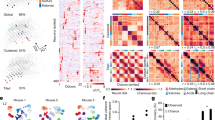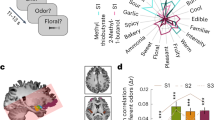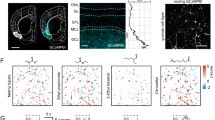Abstract
Because of their unique properties, enantiomers (pairs of mirror-symmetric, nonsuperimposable molecules that differ only in optical activity and their interaction with other chiral molecules) have been instrumental in demonstrating that olfactory perception relies on molecular shape. To investigate how molecular structure is encoded by the olfactory system, we combined behavioral discrimination tasks with optical imaging of intrinsic signals. We found that rats can behaviorally discriminate members of a wide range of enantiomer pairs, and imaging revealed enantiomer-selective glomeruli in the olfactory bulb, indicating that the spatial pattern of glomerular activity provides sufficient information to discriminate molecular shape.
This is a preview of subscription content, access via your institution
Access options
Subscribe to this journal
Receive 12 print issues and online access
$209.00 per year
only $17.42 per issue
Buy this article
- Purchase on Springer Link
- Instant access to full article PDF
Prices may be subject to local taxes which are calculated during checkout


Similar content being viewed by others
References
Doty, R. L. Experientia 42, 257–271 (1986).
Mombaerts, P. Annu. Rev. Neurosci. 22, 487–509 (1999).
Stewart, W. B., Kauer, J. S. & Shepherd, G. M. J. Comp. Neurol. 185, 715–734 (1979).
Johnson, B. A., Woo, C. C. & Leon, M. J. Comp. Neurol. 393, 457–471 (1998).
Friedrich, R. W. & Korsching, S. I. Neuron 18, 737–752 (1997).
Rubin, B. D. & Katz, L. C. Neuron 23, 499–511 (1999).
Uchida, N., Takahashi, Y. K., Tanifuji, M. & Mori, K. Nat. Neurosci. 3, 1035–1043 (2000).
Belluscio, L. & Katz, L. C. J. Neurosci. (in press).
Hildebrand, J. G. & Shepherd, G. M. Annu. Rev. Neurosci. 20, 595–631 (1997).
Laska, M. & Teubner, P. Chem. Senses 24, 161–170 (1999).
Laska, M., Liesen, A. & Teubner, P. Am. J. Physiol. 277, R1098–R1103 (1999).
Slotnick, B. M. in Comparative Perception (eds. Stebbins, W. & Berkley, M.) 155–214 (Wiley, New York, 1990).
Rouquier, S. et al. Nat. Genet. 18, 243–250 (1998).
Ma, M. & Shepherd, G. M. Proc. Natl. Acad. Sci. USA 97, 12869–12874 (2000).
Laurent, G. Curr. Opin. Neurobiol. 4, 547–553 (1997).
Acknowledgements
We thank D. Fitzpatrick, D. Katz, R. Mooney and S. Simon for discussions and comments on the manuscript.
Author information
Authors and Affiliations
Corresponding author
Rights and permissions
About this article
Cite this article
Rubin, B., Katz, L. Spatial coding of enantiomers in the rat olfactory bulb. Nat Neurosci 4, 355–356 (2001). https://doi.org/10.1038/85997
Received:
Accepted:
Issue Date:
DOI: https://doi.org/10.1038/85997
This article is cited by
-
Antagonistic odor interactions in olfactory sensory neurons are widespread in freely breathing mice
Nature Communications (2020)
-
Neuronal pattern separation in the olfactory bulb improves odor discrimination learning
Nature Neuroscience (2015)
-
Perceptual judgements and chronic imaging of altered odour maps indicate comprehensive stimulus template matching in olfaction
Nature Communications (2013)
-
Olfactory discrimination ability of South African fur seals (Arctocephalus pusillus) for enantiomers
Journal of Comparative Physiology A (2013)
-
Rats can make relative perceptual judgments about sequential stimuli
Animal Cognition (2012)



